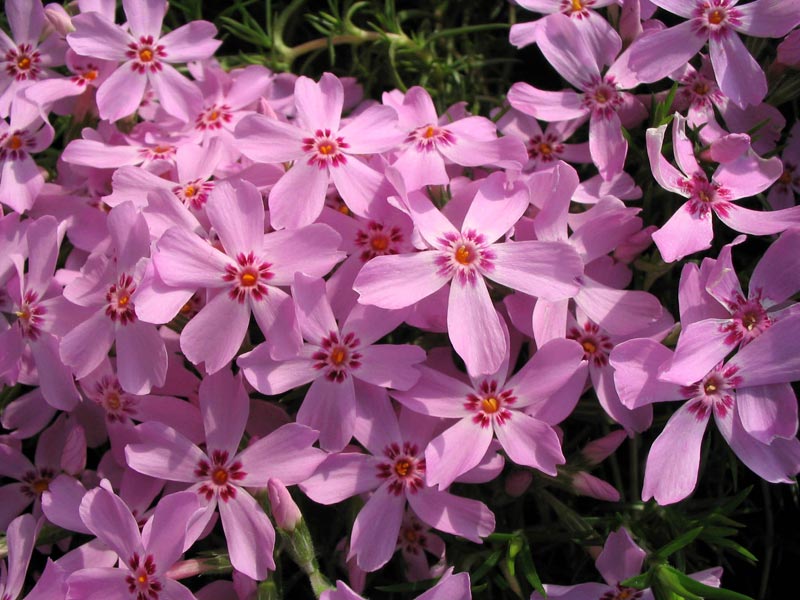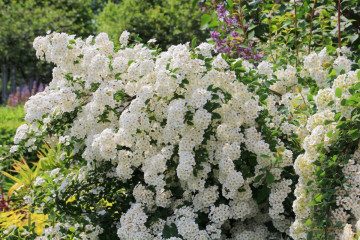Phlox flowers: varieties, what they look like, types
Content:
Phloxes are deservedly recognized as the most common flowers in personal plots. Bright multi-colored plants are easy to grow even for a novice gardener. They are unpretentious and tolerate frosty winters well. They bloom for a long time and fill the garden with a pleasant sweetish smell. Bred in the middle of the 18th century, these plants get their name from the bright flowers that flash over dense greenery. All about phlox is described below.
How garden phlox bloom: description, types
Phlox flowers have more than 80 varieties. There are perennials and annuals. Caring for them is quite simple, but there are nuances and features. The phlox flower loves moisture and frequent watering, but does not withstand stagnant groundwater near its root system. Swampy areas are also not suitable for cultivation. They prefer sunny places. With a slightly shaded flower bed, flowering will not be as abundant as on the sunny side, but longer.
Planted with open roots in early spring or autumn. Flowers with a closed root system can be planted throughout the season. You can not place a flower bed with these flowers next to trees or shrubs. The root system of a stronger plant will easily destroy the flowers. It should also be remembered when weeding that the root system can easily be damaged by the roots of the weeds.
Perennial phlox varieties can be propagated using:
- stem grafting;
- cuttings of roots;
- using seeds;
- dividing the bush;
- germination of buds or shoots.
Most of the varieties are perennials, bushy, creeping or semi-bushy, turf-shaped. Shrub plants are subdivided into tall and short ones. The most common and easy to care for are the following:
- subulate
- groundcover
- Canadian
Subulate variety
A flower brought to Europe and Russia from America. Named subulate because of the pointed leaves. A creeping plant with bright or pale flowers and a delicate aroma. The height does not exceed 25 cm, and in width it can grow up to 150 cm.
What subulate phlox look like: the branches have a flat, five-pointed shape. The diameter, depending on the grade, ranges from 150 to 250 mm. Subulate varieties bloom up to a month in early summer.
Thanks to its root system and structure, it can grow with a soil of only 5 cm. This feature allows flowers to settle comfortably even in rocky terrain. These flowers soften and decorate the stone design of the backyard or suburban area.
The subulate flowers can grow in one place for more than 5 years and quickly take up all the space provided.
Ground cover varieties - flower garden decoration
This is the name for all types of creeping phlox and some types of loose sod. The name speaks - these flowers cover the entire allocated space with a bright, fluffy and fragrant carpet. At the peak of flowering, only a colored cloud is visible, small leaves are hidden under the blossoming buds.
Non-aggressive and unpretentious plants, with small needle-like leaves, take root well on dry and non-nutritious types of soils.
Easily relate to close proximity to other plants and flowers, but look best on their own. Ideal for creating all kinds of design solutions for the garden: flower beds, rock gardens, lawns, flowerpots.
Variety canadian
Phlox Canadian, or splayed - a perennial plant. Herbaceous, high: reaches 40-50 cm. Leaves are acutely oblong, up to 5 cm long. The flowers are flat, in the shape of an asterisk, the color range is predominantly blue: from white and pale blue to bright blue and bright purple.
The peak of flowering occurs in late spring - early summer. Duration is 4-5 weeks. Unpretentious, they take root on dry and slightly acidic soils. Grows easily in both sunny and shaded areas.
After flowering is complete, the plant needs to be pruned to prepare for the next season.
Other types
Thanks to the work of world breeders, at the beginning of 2019, more than 1.5 thousand different varieties were bred. Of these, only one species - the Drummond variety - is a one-year-old. The rest of the varieties are subdivided according to the variety of shades, plant height, inflorescences, leaves, root system.
There are flowers that look like a bouquet - up to 50 buds are located on one stem. There are varieties in which each inflorescence is on a separate shoot. If you combine varieties, then you can organize a full-fledged flower garden that will not need additional types of flowers.
Choice by bloom color
Phlox perennial low-growing varieties, as well as other varieties, are divided into main types:
- phlox white;
- early blue phlox;
- yellow phlox;
- phlox pink;
- phlox red;
- spotted phlox;
- raspberry phlox;
- phlox purple.
Varietal plants can change color only with further seed propagation. Sometimes on the petals of the same color, closer to the center, a crumb of a different shade appears. Such a flower is called mealy or spotted.
Large-flowered and small-flowered species are often planted side by side, while observing either the flowering sequence or a certain design idea. When composing a landscape composition, it is necessary to fully collect information about each variety planted. Also be sure of its color, as this affects the result.
Unpretentious, they easily get along with other flowers, but not with a bush or tree. When drawing up a flower arrangement, it should be borne in mind that plants grow every year.
What do phlox leaves look like?
The leaves differ depending on the cultivars.
- Paniculata have a large number of wide, lush leaves.
- Subulate - narrow, long, slightly curled leaves. Moreover, depending on the variety, both 2-3 leaves and up to 45 pieces can be located on the stem.
- Canadian, spread out, has lush curly leaves, with pointed edges.
Which variety is better for a beginner
Phlox are unpretentious plants that can sprout on any soil. Even an inexperienced gardener will have no difficulty in growing any variety. Of course, field phlox is not suitable for a summer residence, but plants bought in a special store can please the eye for several years.
You can also take planting material from friends or neighbors.
A novice florist today has a large selection.Plants can be selected, focusing on your taste or making up a certain floral ornament. Caring for, watering and feeding these flowers does not cause any particular difficulties.
Phlox-like flowers
In nature, there are flowers that are visually similar to phlox. They are related by a straight stem with inflorescences in the form of a ball or head. Perennial armeria, unlike phlox, has straight and smooth stems. The flowering period is also much longer - from late spring to mid-autumn.
Hydrangea is a flower with spherical inflorescences. It is a long-flowering plant that changes color depending on the type of soil. Suitable for indoor cultivation.
The ground cover plant alyssum with its inflorescences is similar to the flowers of a stunted phlox. Its characteristic colors are dull, from white to pale pink.
"Fire flower" in landscape design
When decorating a personal plot, everything depends on the designer's imagination. Phloxes are ideal for framing a miniature pond, gazebos, paths, rock gardens. You can also subdivide the site into zones or allow the plant to tighten some area. You can create a pyramidal or striped flower garden.
In any case, these flowers will advantageously decorate a dacha or a vegetable garden, if necessary, they will cover a rocky section of the garden.
Next to what flowers on the site can phlox be planted
Phloxes perfectly coexist with any herbaceous perennials. A good solution would be to plant flowers on one flower bed that bloom in a different time period. Alpine aster, bells, geranium or edelweiss will become such partners.
Any variety of phlox is ideal for adding color to the backyard. It is easy to make an ideal and unique composition, it is enough to study what types of phlox are and where they can be planted. Phlox is the most resistant flower and a real decoration of the garden area.




















